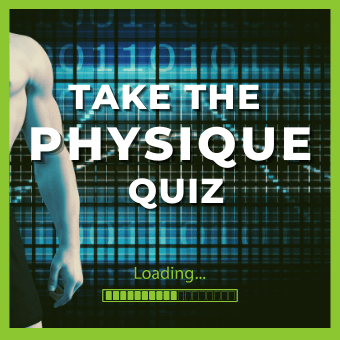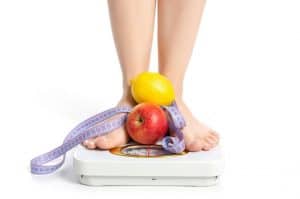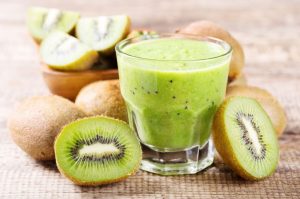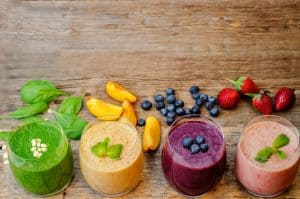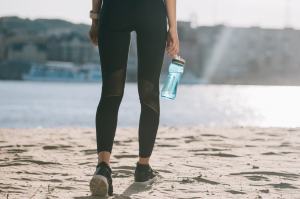A cold shower after a workout is an excellent way to cool off after an intense workout. Moreover, lowering the temperature of the water for your shower can increase blood circulation and reduce inflammation.
So does this mean that taking a cold shower is healthy?
Does it have any side effects that you should worry about?
To answer that, let’s first explore what happens to your body during and after a grueling workout.
What Happens When You Work Out
A lot happens to your body when you work out.
There are so many processes that take place in your body at all times, even for the smallest of actions such as a rotation of the hand.
Throughout this article, we’re going to simplify some of these physiological processes to aid your understanding of the impact a cold shower can have on the body post workout
Whenever you exercise and feel the adrenaline rushing through your veins, you should notice that your heart beats faster and you feel much stronger. This is because your heart is working overtime to deliver enough oxygen around the body to create the energy required for working out.
However, the energy that circulates the body doesn’t always reach the muscles in time or falls short of our expectations of what we should be able to lift.
This is due to lactic acid build-up.
Lactic Acid
Lactate or lactic acid is a byproduct caused by the rigorous and consistent use of muscles.
When there isn’t enough oxygen to produce pyruvate, which helps produce energy in the metabolic cycle, glycogen is used instead.
The byproduct of glycogen is lactic acid, which can also be used for energy but it isn’t all smooth sailing. Without boring you with all the details, lactic acids form around your muscles during a workout.
Even though lactic acid is an energy source, an excess of it can cause physiological problems for your body.
To combat soreness and muscle cramps, lactic acid is usually expelled from the body within 24 hours.
However, even if lactic acid has been released from your body, you will still feel muscle soreness after working out – sometimes even a few days later.
Moderate vs. Intense Workouts
Can you increase or decrease the amount of lactic acid build-up in your body depending on the type of exercise you do? Yes.
Lactic acid builds up much more quickly during intense workouts since training this way usually means pushing yourself to the limit.
This is most common in anaerobic exercises where you’re running or consistently out of breath. For situations like this, lactic acid gives you a lot more energy than usual since your oxygen levels are low.
In cases like that, your heart won’t be able to keep up with the demand for oxygen which results in the production of more glycogen and lactic acid around your body.
Now, this doesn’t mean moderate training doesn’t produce lactic acid.
Just because you don’t feel as sore or fatigued, it doesn’t mean lactic acid isn’t present in your system. It simply means that there isn’t enough lactic acid for you to feel the full effects.
Simply put, lactic acid will appear regardless of the intensity of the exercise, just not as much with moderate workouts as with intense sessions.
Benefits of a Cold Shower After Workout

Now that you understand what happens to your body when you work out, it’s time to go over the benefits of both cold and hot showers.
Since both hot and cold showers have their advantages, to get the best of both worlds, some fitness enthusiasts like to combine the two.
An intense workout can often leave you hot and sweaty from all the adrenaline. Rewarding yourself with a cold shower is a great way to cool off and rest your muscles after pumping iron.
Here are some of the benefits of taking a cold shower post-workout:
1. Reduces Inflammation
Working out breaks muscle cells down, and it’s actually the reparation process that converts them into bigger and stronger muscles.
When your body realizes that you’re under physical stress, blood and other cells work together to fix you up.
The surge of these blood vessels can cause acute inflammation since these blood vessels gather in groups around damaged muscles.
While inflammation can arguably influence muscle growth, it’s not a good idea to have prolonged or excessive inflammation, especially after an intense workout.
As a result, relieving some of the inflammation with a cold shower can lower the risk of injury and accelerate the recovery process. Cold showers can also lower blood pressure, while the mast cells caused by hot showers can have the opposite effect.
2. Increases Circulation
By splashing yourself with cold water after an intense workout, the surface of your skin constricts, forcing your body to move blood around more quickly.
Increased blood flow as a result of an ice cold shower internally will reduce blood flow around the surface of your body which will eventually lower your temperature.
Your heart is then forced to pump out more blood to maintain the ideal body temperature. Increasing your circulation reduces inflammation and flushes out the lactic acid in your muscles much faster than normal.
While it’s not the same as an ice bath or cryogenic chamber, the same principles apply for strongmen who take extremely cold recovery baths after working out.
We’ll expound on the benefits and differences of that later.
Benefits of a Hot Shower After Workout
On the other end of the spectrum, hot showers also provide a lot of health benefits when taken after an intense workout.
Though you should take these benefits with a pinch of salt, since the positive effects of a hot shower after a workout are dubious.
Besides removing dirt more effectively and feeling a lot more comfortable, hot showers can do a lot for your heart and blood flow.
1. Increases Blood Flow
Blood flowing through your body helps you unwind and will relieve sore muscles.
This extends to muscles that are tense or wrapped up in a tight knot.
While hot showers boost circulation, the real increase here is the amount of blood flowing through your body.
By bathing in hot water, your muscles loosen up from the intense workout, which takes away a lot of the initial stress and fatigue.
2. Other Perks of Hot Showers
Though the information behind this is still quite hazy, hot showers reportedly activate the parasympathetic nervous system which helps relieve tension by relaxing the muscles.
Furthermore, hot showers loosen up phlegm, open up your airways, and can clear the nasal passages to relieve other parts of your body.
Taking Both Hot And Cold Showers
Should you take a cold or hot shower after a workout?
Well, both are advantageous, and It’s not uncommon for people to enjoy both types of showers.
While you can go about this in different ways and for various sets of time, we generally recommend going under a hot shower first and ending with a cold one – just like the Romans would have done with their public baths.
Doing this will open up your pores first, which should give you a deeper cleanse and a more satisfying bath.
Before stepping out, rinse yourself off with cold water to close your pores and bring your body temperature down.
This way, even if you just do a cold shower for two minutes, you won’t be sweating out of your shirt once you’re done changing.
Finally, cold showers will close up your pores and increase circulation which should make you feel fantastic once you’re done.
The Specifics Of Inflammation
If you’ve ever searched about inflammation online, you will undoubtedly have stumbled upon articles that mention injuries, bacteria, and viruses.
Many things can cause inflammation and, there are several different types of inflammation you should be aware of.
Working out usually causes acute inflammation, which is simply the result of your body’s attempt to repair itself after the muscle cells have been broken down.
Symptoms Of Inflammation
While inflammation can be uncomfortable at best and painful at worst, spotting the signs should be easy enough.
Here are a couple of symptoms to help you spot any signs of inflammation around your body:
- Redness – look out for signs of redness around your body, especially with your joints. Inflamed muscles will stay red for hours.
- Joint Pain and Stiffness – much more common on knees and shoulders, inflamed joints will be painful and even stiff to move.
- Warm Joints – inflamed joints are warm and even a little hot due to heat as a byproduct of the energy used to repair the stress on your muscles. Put your hand over red spots to check if they feel warm to the touch.
Other signs and symptoms include general muscle stiffness and fatigue.
On an unrelated note, these are also symptoms of inflammation but they shouldn’t occur from just working out: slight fevers, chills, headaches, and even a loss of appetite.
Acute Inflammation
Short-term and generally not serious, acute inflammation is the type of inflammation you will most often experience after working out.
Acute inflammation is a response to broken muscle cells or injured tissues.
This type of inflammation caused by working out should go away within a couple of days and isn’t a serious health risk.
However, acute inflammation can slow down your recovery process which is why cold showers are worth considering to help recover your body from an intense workout.
Chronic Inflammation
Chronic inflammation shouldn’t be an issue under normal circumstances, since you won’t experience this from working out.
This type of inflammation is serious and can be life-threatening especially in some situations.
Chronic inflammation is common in the head, heart, organs, major joints, and more, which can be debilitating.
You don’t have to worry so much about this type of inflammation from just working out though but remember to be careful lifting heavy weights since concussions can bring about serious inflammation that could become chronic.
Chronic inflammation requires medication and surgery to remove or treat, which is expensive.
Related: How to Get Flexible Fast
Alternatives To Cold Showers After a Workout
There are alternatives to cold showers that are more effective – if you can afford them.
If you really want to step up your post-workout recovery, and use the cutting edge methods many athletes rely on, here are a few of your options:
Ice Bath

Ice baths are a classic technique that are prevalent in the world of sports and beyond, often featuring in Hollywood movies.
And Why not?
Ice baths are affordable after all and for the longest time were viewed as the best way to recover from intense workout sessions.
The freezing water of an ice bath significantly reduces inflammation, much more so than a simple cold shower.
Constricting your blood vessels with the cold and dilating them with warm temperatures—when you get out—helps to flush away metabolic waste like lactic acid after working out.
Cryogenic Chamber
Now there are a lot of other famous and expensive alternatives to the ice bath in recent years. However, cryotherapy is arguably the most notorious alternative since most sessions only last up to three minutes and are extremely effective.
Although it is a bit on the pricier side, cryogenic chambers help relieve muscle pains, sores, and reduce inflammation much better than regular ice baths.
It’s worth noting that cryotherapy is a hundred or so degrees colder than ice baths.
Furthermore, since liquid nitrogen doesn’t actually touch your skin, there is no risk for frostbite.
Frequently Asked Questions About Cold Shower After Workout
Is taking a cold shower after working out bad?
No, in fact, it could be the best thing you do if you want to speed up muscle recovery.
A cold shower will reduce inflammation in your muscles, help flush out lactic acid, and increase the circulation in your body.
All of which are great ways to help you recover faster and avoid possibly long acute inflammation which can lengthen recovery.
Do cold showers help build muscle?
To be honest, the research on this is a little hazy.
A lot of articles will claim that it does increase build muscle while others will point you to research that says it reduces muscle gain. There are a lot of factors in muscle growth, like diet and workout intensity.
While cold showers and increased muscle growth aren’t necessarily directly correlated, taking a cold shower will increase the rate of recovery for your body. With that, you should be able to work out more frequently and not feel as sore which does build muscle.
Should I take a cold shower immediately after working out?
While there are people who will advise you not to, we believe taking a cold shower straight after a workout is a great idea.
Showering after a workout is an excellent way to protect your body from breakouts and decreases your body’s temperature much faster than if you were to just wait.
However, keep in mind that it isn’t necessary to jump in immediately.
Related: How to Build Muscle Without Weights
Get Your Free "Fight Club Physique" Checklist
A Final Word on Cold Showers
Taking a cold shower after a workout is a great way to relieve your muscles, increase blood circulation, boost your immune system and assist your body in flushing out the lactic acid building up in your muscles.
Furthermore, the cold temperatures will reduce the inflammation in your muscles, which will help speed up the recovery process.
At the same time, for increased comfort, cold showers ironically make you feel much better once you’re dried.


